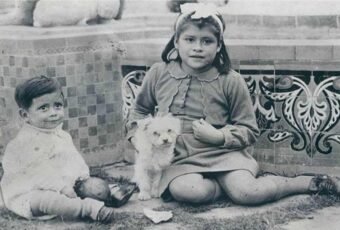Roy Sullivan was struck by lightning seven times between 1942 and 1977 and survived each one. As a result, he earned the nicknames “Human Lightning Conductor” and “Human Lightning Rod.” Guinness World Records lists Sullivan as the person who has been struck by lightning the most times.

The odds of getting struck by lightning seven times are 4.15 in 100,000,000,000,000,000,000,000,000,000,000.
But this feat came at a cost, people avoided him later in life because they were afraid of being struck by lightning, which saddened him. He recalled once, “For example, one day while walking with Chief Ranger, lightning struck far away (in the distance). ‘I’ll see you later,’ said the Chief.”
Sullivan’s wife was also struck once when a storm arrived unexpectedly while she was hanging clothes in their back yard. Her husband was there to assist her at the time, but he escaped unharmed.
Roy Sullivan was born on February 7, 1912, in Greene County, Virginia, and began working as a ranger at Shenandoah National Park in 1936. He was described as a tough-looking man with a broad, rugged face.
Roy Sullivan’s first instance of lightning in 1942
In April 1942, Sullivan experienced his first lightning strike. He was hiding in a fire lookout tower from a thunderstorm. The tower was brand new at the time and lacked a lightning rod; it was struck seven or eight times. “Fire was jumping all over the place” inside the tower. Sullivan dashed outside and received what he considered to be his worst lightning strike just a few feet away. It burned a half-inch strip down his right leg, struck his toe, and ripped a hole in his shoe.
Second Strike knocked him out
In July 1969, he was struck again. He was struck while driving on a mountain road, which is unusual because the metal body of a vehicle normally protects people from lightning strikes by acting as a Faraday cage. The lightning struck nearby trees before being deflected into the truck’s open window. The strike knocked Sullivan out, burned off his brows and eyelashes, and set fire to his hair. The uncontrollable truck continued to move until it came to a stop near a cliff edge.
Third Strike, but not much harm
Sullivan was hit in his front yard in July 1970. Lightning struck a nearby power transformer and jumped to his left shoulder, searing it.
By 4th strike, he developed the fear of death
Sullivan was struck again in 1972 while working inside a ranger station in Shenandoah National Park. It caught fire in his hair, and he tried to smother the flames with his jacket. He then dashed to the restroom, but he couldn’t fit under the water faucet and had to make do with a wet towel. Although he was never afraid, after the fourth strike he began to believe that some force was attempting to destroy him, and he developed a fear of death.
For months, whenever he was driving his truck and got caught in a storm, he would pull over and lie down on the front seat until the storm passed. He also began to believe that if he stood in a crowd of people, he would attract lightning, and he carried a can of water with him in case his hair caught fire.
Fifth Strike, Roy Sullivan saw the lightning bolt that struck him
On August 7, 1973, while on patrol in the park, Sullivan noticed a storm cloud forming and quickly drove away. However, he later stated that the cloud appeared to be following him. He decided it was safe to leave his truck when he thought he had finally outrun it. A lightning bolt struck him shortly after. Sullivan claimed to have seen the bolt that struck him. The lightning struck his left arm and leg, knocking his shoe off. It then moved to his right leg, just below the knee. Still conscious, Sullivan crawled to his truck and poured the can of water he always kept there over his on-fire head.
Sixth strike set his hair on fire
On June 5, 1976, he was hit again, injuring his ankle. According to reports, he saw a cloud, thought it was following him, tried to flee, but was hit anyway. His hair was also on fire.
Seventh Strike, he fought a bear after getting hit by lightning
Sullivan was struck while fishing in a freshwater pool on Saturday, June 25, 1977. Lightning struck the top of his head, setting fire to his hair before traveling down and burning his chest and stomach. When Sullivan turned to go back to his car, an unexpected event occurred: a bear approached the pond and attempted to steal a trout from his fishing line. Sullivan mustered the courage and strength to strike the bear with a tree branch. He claimed that this was the twenty-second time in his life that he had hit a bear with a stick.
The one who documented the strikes was never present when it happened
R. Taylor Hoskins, superintendent of Shenandoah National Park, documented all seven strikes. Hoskins, on the other hand, was never present at any of the reported strikes and was not an active and present superintendent in Shenandoah National Park during many of the alleged strikes against Sullivan.

Sullivan himself recalled being struck by lightning for the first time much earlier than 1942. When he was a child, he was assisting his father in cutting wheat in a field when a thunderbolt struck the blade of his scythe, but he was unharmed. However, because he was unable to prove the fact later, he never claimed it.
Sullivan died on September 28, 1983, at the age of 71, from a self-inflicted gunshot wound to the head. Two of his ranger hats can be seen at the Guinness World Exhibit Halls in New York and South Carolina.












Follow Us